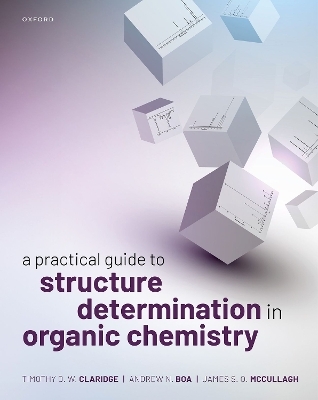
A Practical Guide to Structure Determination in Organic Chemistry
Oxford University Press (Verlag)
978-0-19-871256-5 (ISBN)
- Noch nicht erschienen (ca. April 2025)
- Versandkostenfrei
- Auch auf Rechnung
- Artikel merken
A Practical Guide to Structure Determination in Organic Chemistry offers a highly accessible and hands-on introduction to identifying the molecular structure of organic compounds from spectroscopic data.
It sets out a systematic approach to using and integrating spectroscopic data in a way that helps the reader to develop their skills in interpreting MS, NMR, and IR spectra in order to solve structure determination problems. In-depth discussions of worked examples show how to effectively gather and evaluate clues from different types of spectra, and a set of practice problems allows students to apply these principles themselves to deepen their understanding.
The book also offers insights into how more advanced NMR and MS techniques, including two-dimensional NMR and tandem mass spectral methods, are used and can provide clues for finalizing the assignment of molecular structure in challenging cases.
Key features
- Introduces a systematic approach for determining the molecular structure of organic compounds by drawing on data from different spectroscopic techniques
- Exemplifies strategies for determining structures by working through detailed worked examples step-by-step
- Provides more than 15 practice problems that increase in difficulty and allow the reader to build their skills in structural analysis
- Includes a handy checklist of information that can be derived from different types of spectra and practical tips for interpreting real-world samples
Digital formats and resources
A Practical Guide to Structure Determination in Organic Chemistry is available for students and institutions to purchase in a variety of formats.
The e-book and Science Trove offer a mobile experience and convenient access, along with functionality tools and navigation features: www.oxfordtextbooks.co.uk/ebooks
Tim Claridge is Visiting Professor of NMR Spectroscopy in the Department of Chemistry at the University of Oxford and Associate Director, NMR Analytics, at Exscientia Ltd. He has contributed to over 250 research publications and written a number of textbooks covering spectroscopy, including High-Resolution NMR Techniques in Organic Chemistry and the Oxford Chemistry Primer Introduction to Organic Spectroscopy (with Laurence M. Harwood). Andrew Boa is a Senior Lecturer in Organic Chemistry at the University of Hull. He holds a DPhil in Chemistry from the University of York and has 29 years of experience in teaching organic and bio-organic chemistry. His research interests cover all aspects of organic and bio-organic chemistry and extend to applications for the biosourced polymer sporopollenin. James McCullagh is Professor of Biological Chemistry and Director of the Mass Spectrometry Research Facility in the Department of Chemistry at the University of Oxford. He has 20 years of experience in the development of (bio)analytical chemistry techniques, in particular using mass spectrometry, with applications in chemical, biological, and medical research. He has contributed to over 150 journal publications, book chapters, and articles, as well as a textbook on Mass Spectrometry (with Neil J. Oldham) in the Oxford Chemistry Primers series.
1: Introduction
2: Analysis of 1H NMR spectra
3: Analysis of 13C NMR spectra
4: Analysis of infrared spectra
5: Analysis of electron ionization (EI) mass spectra
6: Dealing with spectra from real samples
7: Analysis checklist
8: Worked examples
9: Problems
10: Advanced NMR methods
11: 2D NMR and spectrum editing: Worked examples and problems
12: Advanced mass spectrometry methods
Appendix 1: Data tables
Appendix 2: Solutions to self-study problems
| Erscheint lt. Verlag | 30.4.2025 |
|---|---|
| Verlagsort | Oxford |
| Sprache | englisch |
| Maße | 219 x 276 mm |
| Themenwelt | Naturwissenschaften ► Chemie ► Analytische Chemie |
| Naturwissenschaften ► Chemie ► Organische Chemie | |
| ISBN-10 | 0-19-871256-1 / 0198712561 |
| ISBN-13 | 978-0-19-871256-5 / 9780198712565 |
| Zustand | Neuware |
| Haben Sie eine Frage zum Produkt? |
aus dem Bereich


